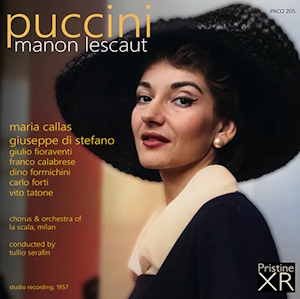
Giacomo Puccini (1858-1924)
Manon Lescaut – opera in four acts (1893)
Manon Lescaut – Maria Callas (soprano)
Des Grieux – Giuseppe di Stefano (tenor)
Lescaut – Giulio Fioravanti (baritone)
Geronte – Franco Calabrese (bass)
Edmondo – Dino Formichini (tenor)
Una voce sola – Fiorenza Cossotto (mezzo-soprano)
L’oste – Carlo Forti (baritone)
Il maestro di ballo – Vito Tatone (tenor)
Un sergente degli arcieri – Giuseppe Morresi (baritone)
Lampionaio – Franco Ricciardi (tenor)
Un comandante di Marina – Franco Ventriglia (bass)
Chorus & Orchestra of La Scala, Milan/Tullio Serafin
rec. 18-27 July 1957, Teatro alla Scala, Milan
Pristine Audio PACO205 [2 CDs: 121]
What a pleasure it has been to discover this recording again after not having heard it for more than 35 years. Pristine snazzy new bottle may contain some old wine but what a vintage it is. EMI’s recording sessions for this occurred in 1957 but for some reason they delayed releasing it until late 1959, coinciding roughly with their release of Callas’ Medea recording, also conducted by Tullio Serafin. By then the difference in the declining state of Callas’ voice was really quite apparent. This Manon Lescaut was cautiously welcomed by the critics at that time, especially as it had plenty of competition from RCA with the Licia Albanese set (review), and Decca with the release of Renata Tebaldi’s stereo version (review).
The main drawback of this set has always been the rather tightly limited acoustic, as if the cast had crowded into a claustrophobic room to make the recording. Pristine’s XR sound process has ameliorated this so that the sound has a more relaxed, almost resonant acoustic. The voices seem to register more naturally with the listener. Top marks to engineer Andrew Rose for his achievement here.
The first voice we hear is Dino Formichini’s engaging Edmondo. This is followed closely by Di Stefano’s entrance as Des Grieux. The almost relentlessly bright edge to Di Stefano’s voice makes the young chevalier sound really impetuous. As a singer he is more rhythmically scrupulous than either Placido Domingo on two rival recordings, or Jose Carreras. Just sample Di Stefano’s phrase as he introduces himself to Manon in the first scene to get a sense of what I am referring to. Occasionally some flatness will intrude in his top notes, but that is compensated overall by his demeanor, and for this singer, an uncharacteristic restraint whereas the other tenors will push the intensity of Puccini’s phrases too early on.
Callas’ Manon is bewitching from her very first entrance. Her little inflections in the vocal line illuminate the character in a way that no other soprano has ever dared to try. The crowning dramatic touch in her performance is the mocking tone that she injects into her voice when she rebukes her elderly lover in the Second Act. This is vocal acting of the highest order. Yes there are one or two shaky top B’s and C’s but this is a small price to pay for such an all-encompassing portrayal. The control of her vocal line at the close of “In quelle trine morbide” is simply breathtaking.
Fioravanti is one of the more effective Lescauts on record. His vibrant, woodwind-like tone perfectly conveys the louche character of Manon’s brother. As the wealthy Geronte, Calabrese’s slightly hollow-sounding bass makes a vividly lecherous fellow. Fiorenza Cossotto’s appearance as the madrigal singer reveals her star quality at an early stage in her career.
Tullio Serafin conducts a leisurely yet finely-controlled reading of the score. Nothing is overpointed or hurried but the grand moments always get their due. His shaping of the famous intermezzo seems more a part of the opera than usual, especially as he refuses to draw undue attention to the rise and fall of the music. This is a common failing among other conductors (i.e. Sinopoli) of this piece, as they strive for maximum effect in certain places. It usually has the effect of making the intermezzo sound more exciting but it pulls the dramatic arc of the opera out of shape. The La Scala orchestra and especially the chorus respond to Serafin’s lead with astonishing concentration. On this occasion Walter Legge’s production is expertly managed and only falls short in the moment when Manon and Des Grieux flee from the Inn. At this point the muted trumpets are spotlighted far too loudly and overwhelm the sound picture. Ideally one would want a to own good stereo version of this opera, especially as Serafin makes a cut of several bars of music in the final act. My personal recommendation would be the Sinopoli recording on DG (review) ,or the Chailly version on Decca. However, the dramatic potential of this opera has never been more fully realized in sound as it was by Callas, Di Stefano and Serafin. Pristine’s splendid remastering is definitely the top choice among the various reissues of this jewel of a recording.
Mike Parr
previous review by Ralph Moore
Availability: Pristine Classical

















